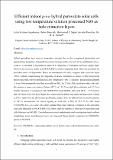Files in this item
Efficient indoor p-i-n hybrid perovskite solar cells using low temperature solution processed NiO as hole extraction layers
Item metadata
| dc.contributor.author | Krishnan Jagadamma, Lethy | |
| dc.contributor.author | Blaszczyk, Oskar | |
| dc.contributor.author | Sajjad, Muhammad T. | |
| dc.contributor.author | Ruseckas, Arvydas | |
| dc.contributor.author | Samuel, Ifor D. W. | |
| dc.date.accessioned | 2020-04-27T10:30:02Z | |
| dc.date.available | 2020-04-27T10:30:02Z | |
| dc.date.issued | 2019-10 | |
| dc.identifier.citation | Krishnan Jagadamma , L , Blaszczyk , O , Sajjad , M T , Ruseckas , A & Samuel , I D W 2019 , ' Efficient indoor p-i-n hybrid perovskite solar cells using low temperature solution processed NiO as hole extraction layers ' , Solar Energy Materials and Solar Cells , vol. 201 , 110071 . https://doi.org/10.1016/j.solmat.2019.110071 | en |
| dc.identifier.issn | 0927-0248 | |
| dc.identifier.other | PURE: 259672942 | |
| dc.identifier.other | PURE UUID: fd09d4fe-ab8a-4665-ac5a-03abb141bd05 | |
| dc.identifier.other | ORCID: /0000-0001-9114-3522/work/60630714 | |
| dc.identifier.other | ORCID: /0000-0002-4339-2484/work/60630932 | |
| dc.identifier.other | Scopus: 85070186673 | |
| dc.identifier.other | WOS: 000487572500035 | |
| dc.identifier.uri | https://hdl.handle.net/10023/19857 | |
| dc.description | We are grateful to the European Commission for financial support through the grant, EXCITON 321305. Dr. L.K.Jagadamma acknowledges support from a Marie Skłodowska-Curie Individual Fellowship (European Commission) (MCIF: No. 745776). We are also grateful to EPSRC for an equipment grant (EP/L017008/1). | en |
| dc.description.abstract | Hybrid perovskites have received tremendous attention due to their exceptional photovoltaic and optoelectronic properties. Among the two widely used perovskite solar cell device architectures of n-i-p and p-i-n, the latter is interesting in terms of its simplicity of fabrication and lower energy input. However this structure mostly uses PEDOT:PSS as a hole transporting layer which can accelerate the perovskite solar cell degradation. Hence the development of stable, inorganic hole extraction layers (HEL), without compromising the simplicity of device fabrication is crucial in this fast-growing photovoltaic field. Here we demonstrate a low temperature (~100 °C) solution - processed and ultrathin (~6 nm) NiO nanoparticle thin films as an efficient HEL for CH3NH3PbI3 based perovskite solar cells. We measure a power conversion efficiency (PCE) of 13.3% on rigid glass substrates and 8.5% on flexible substrates. A comparison with PEDOT:PSS based MAPbI3 solar cells (PCE ~ 7.9%) shows that NiO based solar cells have higher short circuit current density and improved open circuit voltage (1.03 V). Apart from the photovoltaic performance under 1 Sun, the efficient hole extraction property of NiO is demonstrated for indoor lighting as well with a PCE of 23.0% for NiO based CH3NH3PbI2.9Cl0.1 p-i-n solar cells under compact fluorescent lighting. Compared to the perovskite solar cells fabricated on PEDOT:PSS HEL, better shelf-life stability is observed for perovskite solar cells fabricated on NiO HEL. Detailed microstructural and photophysical investigations imply uniform morphology, lower recombination losses, and improved charge transfer properties for CH3NH3PbI3 grown on NiO HEL. | |
| dc.format.extent | 10 | |
| dc.language.iso | eng | |
| dc.relation.ispartof | Solar Energy Materials and Solar Cells | en |
| dc.rights | Copyright © 2019 Elsevier B.V. All rights reserved. This work has been made available online in accordance with the publisher’s policies. This is the author created, accepted version manuscript following peer review and may differ slightly from the final published version. The final published version of this work is available at https://doi.org/10.1016/j.solmat.2019.110071 | en |
| dc.subject | CH3NH3PbI3 | en |
| dc.subject | Indoor photovoltaics | en |
| dc.subject | Mixed halides | en |
| dc.subject | Time-resolved photoluminescence | en |
| dc.subject | Shelf-life | en |
| dc.subject | QB Astronomy | en |
| dc.subject | QC Physics | en |
| dc.subject | DAS | en |
| dc.subject | SDG 7 - Affordable and Clean Energy | en |
| dc.subject.lcc | QB | en |
| dc.subject.lcc | QC | en |
| dc.title | Efficient indoor p-i-n hybrid perovskite solar cells using low temperature solution processed NiO as hole extraction layers | en |
| dc.type | Journal article | en |
| dc.contributor.sponsor | European Research Council | en |
| dc.contributor.sponsor | European Commission | en |
| dc.contributor.sponsor | EPSRC | en |
| dc.description.version | Postprint | en |
| dc.contributor.institution | University of St Andrews. School of Physics and Astronomy | en |
| dc.contributor.institution | University of St Andrews. Centre for Biophotonics | en |
| dc.contributor.institution | University of St Andrews. Condensed Matter Physics | en |
| dc.identifier.doi | https://doi.org/10.1016/j.solmat.2019.110071 | |
| dc.description.status | Peer reviewed | en |
| dc.identifier.url | https://arxiv.org/abs/1909.03838 | en |
| dc.identifier.grantnumber | en | |
| dc.identifier.grantnumber | 745776 | en |
| dc.identifier.grantnumber | ep/l017008/1 | en |
This item appears in the following Collection(s)
Items in the St Andrews Research Repository are protected by copyright, with all rights reserved, unless otherwise indicated.

